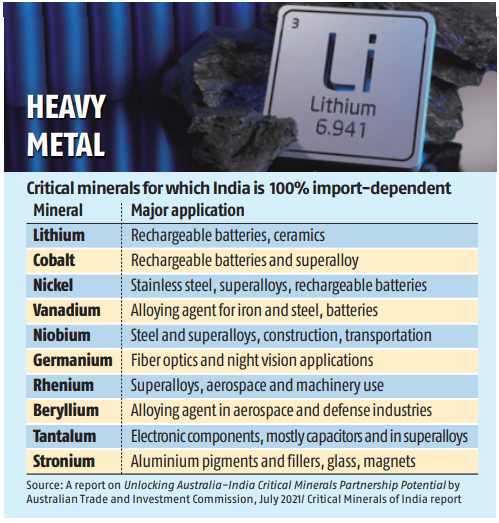ForumIAS announcing GS Foundation Program for UPSC CSE 2025-26 from 19 April. Click Here for more information.
ForumIAS Answer Writing Focus Group (AWFG) for Mains 2024 commencing from 24th June 2024. The Entrance Test for the program will be held on 28th April 2024 at 9 AM. To know more about the program visit: https://forumias.com/blog/awfg2024
Contents
Source: The post is based on the following articles
“Panel finds 30 minerals critical to India” published in the Live Mint on 29th June 2023.
“Centre releases first ever list of 30 critical minerals” published in the Business Standard on 29th June 2023.
What is the News?
In a significant move to enhance its strategic resource security, India has officially released its first-ever Critical Minerals for India report, identifying 30 key critical minerals crucial to the nation’s economic growth and technological development.
What are critical minerals?
Critical minerals are those minerals that are at risk of supply shortage, which may have a larger impact on the economy compared to other raw materials.
Critical minerals have complex global supply chains with a high concentration in the extracting and processing countries, resulting in high supply risks.
About the Critical Minerals for India report
The report aims to reduce import dependence, enhance supply-chain resilience, and support the country’s net-zero objectives. The report was formulated by the Ministry of Mines.
The ministry will be revisiting the critical mineral list periodically.
Need for the report: a) The need for several of critical minerals has grown as they are used for battery manufacturing, both in mobility or electric vehicles and for grid-scale energy storage, b) India has been looking to lower its dependence on imports as much of critical mineral minerals come from China.
What are the key highlights of the Critical Minerals for India report?

The critical minerals list includes a diverse range of minerals considered essential for various industries such as defence, electronics, renewable energy, telecommunications, and transportation, among others.
The list comprises 30 minerals, including 17 rare earth elements (REEs) and six platinum-group elements (PGE), each designated as critical based on their economic importance and limited availability in India’s geological reserves.
Some of the minerals are antimony, beryllium, bismuth, cobalt, copper, gallium, germanium, graphite, hafnium, indium, lithium, molybdenum, niobium, nickel, PGE, phosphorous, potash, REE, rhenium, silicon, strontium, tantalum, tellurium, tin, titanium, tungsten, vanadium, zirconium, selenium, and cadmium.
Ten minerals on the list are 100% import-dependent. These are lithium cobalt, nickel, vanadium, niobium, germanium, rhenium, beryllium, tantalum, and strontium.
What are the key recommendations of the expert committee which formulated the critical minerals list?
Set up a national institute or a centre of excellence for critical minerals: A wing in the Ministry of Mines can be established as a Centre of Excellence for Critical Minerals (CECM). The CECM will focus on identifying more efficient ways for discovering next generation critical mineral deposits through geological knowledge, data analytics and modelling, and machine learning capability. This is on the lines of CSIRO which is an Australian government corporate entity.
The centre of excellence collaborates with international agencies or Khanij Bidesh India Ltd (KABIL) for the strategic acquisition of foreign assets of critical minerals. The centre would also monitor export management with the Ministry of Commerce and Industries and Ministry of external affairs.
How government aims to reduce the import dependency on critical minerals?
-The government plans to encourage public and private investments in exploration, mining, and processing facilities.
-It also intends to facilitate the adoption of advanced technologies and international collaborations to enhance efficiency and environmental sustainability in the extraction and processing of critical minerals.
Note: Earlier this year, the Indian and Australian governments decided to jointly invest $3 million each for five critical mineral exploration projects in Australia. Recently, India entered into the US-led Mineral Security Partnership to secure a global supply chain for critical minerals.




